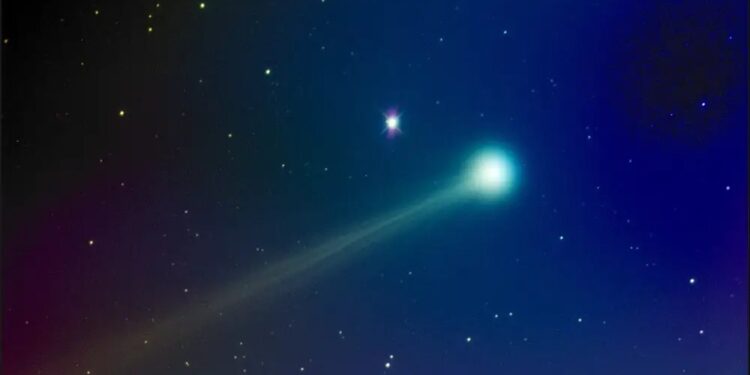- A green comet named C/2022 E3 (ZTF) is approaching Earth, according to NASA.
- The comet most recently passed our planet 50,000 years ago, during the last Ice Age, according to astronomers.
- The comet is expected to be visible at night as it swings past Earth in early February.
A green comet is set to pass by Earth for the first time since the Stone Age, according to NASA’s Jet Propulsion Laboratory, and it may be visible in the skies in late January and early February.
Astronomers discovered the comet, a ball of ice named C/2022 E3 (ZTF), in March 2022. They’d never seen it before, because it takes an incredibly long time to circle the sun, completing an orbit over tens of thousands of years. Modern astronomy didn’t exist last time this comet was in our neighbourhood.
The comet is expected to be about 26 million miles from Earth on February 2. That would be the closest it has been to the Earth in 50,000 years, according to astronomers.

Back then, a period known as the Upper Paleolithic era, was when humans are believed to have left Africa and settled in Asia and Europe. Neanderthals still walked the Earth. The planet was in the middle of the Ice Age.
The icy cosmic visitor will pass our planet at nearly 109 times the average distance of the moon, but the comet is burning so bright that it could still be visible in the night sky.
“Comets are notoriously unpredictable, but if this one continues its current trend in brightness, it’ll be easy to spot with binoculars, and it’s just possible it could become visible to the unaided eye under dark skies,” NASA wrote in an update on December 29.
How, where, and when to spot comet C/2022 E3 (ZTF)
In the Northern Hemisphere, the green comet should be visible just before dawn in late January. At first, spotting it may require a telescope, but as it approaches Earth NASA expects viewers can see it with binoculars.
“The new long-period comet has brightened substantially and is now sweeping across the northern constellation Corona Borealis in predawn skies,” NASA said in a news release December 24. At that time, it was still too dim to see with a telescope.
A completely darkened new moon could provide ideal dark skies for spying the comet on January 21.
In the Southern Hemisphere, the green cosmic snowball will be visible in early February.
Why the comet is green
The comet has a “greenish coma, short broad dust tail, and long faint ion tail,” according to NASA.
Many comets glow green. Laboratory research has linked this aura to a reactive molecule called dicarbon, which emits green light as sunlight decays it.
Dicarbon is common in comets, but it’s not usually found in their tails. That’s why the coma — the haze surrounding the ball of frozen gas, dust, and rock at the center of a comet — is glowing green, while the tail remains white.
The comet likely came from the mysterious Oort Cloud
Experts told USA Today that the comet most likely came from the Oort Cloud, the farthest region of the solar system, which NASA describes as a “big, thick-walled bubble made of icy pieces of space debris the sizes of mountains and sometimes larger.”
The Oort Cloud is the most distant part of our solar system, encircling everything like a “giant spherical shell,” according to NASA. It’s so far away that astronomers measures its distance in astronomical units (AU). One AU is the distance between Earth and the sun. The inner edge of the Oort Cloud is 2,000 to 5,000 AU away.
That distance means astronomers have never observed an object in the Oort Cloud, so it’s still a “theoretical concept,” according to NASA. But astronomers suspect many far-traveling comets like C/2022 E3 (ZTF) come from there.
The comet won’t return for another 50,000 years — if ever
This is your only chance to see comet C/2022 E3 (ZTF), and may be the last chance humanity ever gets.
“We don’t have an estimate for the furthest it will get from the Earth yet—estimates vary—but if it does return it won’t be for at least 50,000 years,” Jessica Lee, an astronomer at Royal Observatory Greenwich, told Newsweek.
“Some predictions suggest that the orbit of this comet is so eccentric it’s no longer in an orbit—so it’s not going to return at all and will just keep going,” she added.
Source: I N S I D E R


Recent Comments